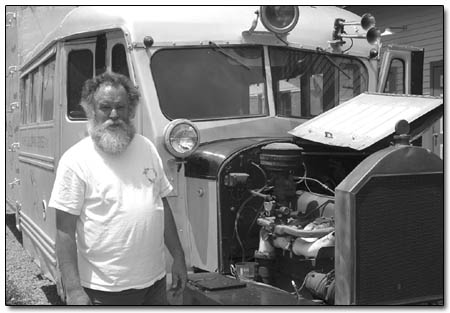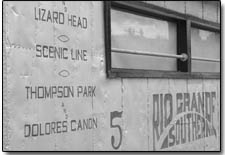 |
Wayne Brown, president of
the Galloping Goose Historical Society, stands Monday beside
the engine he had a part in repairing a few years back.
The hybrid train/bus runs on gasoline. Brown and the Historical
Society are proposing to
restore the old Rio Grande Southern track between Dolores
and Mancos and run twice daily trips on the goose in the
summer months./Photo by Todd Newcomer. |
Several years ago, when Dolores
resident Wayne Brown approached fellow townspeople about restoring
the old Rio Grande Southern Galloping Goose No.5 he was met
with skepticism.
“The community hesitated to allow a group of mostly newcomers
to take their goose apart and rebuild it,” he said.
However, Brown and a group of dedicated rail buffs, calling
themselves the Galloping Goose Historical Society, persevered.
To prove themselves worthy, they started by rebuilding the old
RSG depot in town, where the Goose is now housed.
“Seven of us spent two years rebuilding the depot,”
said Brown, 52, a multidisciplined handy man and self-described
“contract consultant” who specializes in boiler
maintenance. “This showed the community that we had the
wherewithal and expertise to restore the goose.”
Then, in 1996, with the help of a Colorado Historical Society
grant and the town’s blessing, the group set about restoring
beloved Goose No. 5 as well.
“We got the Goose restored in 14 months,” Brown
said of the 70-year-old gasoline-powered railbus.
Now, Brown and his cohorts are embarking on yet another mission:
to restore the old RGS narrow gauge line from Dolores to Mancos
that the Goose once roamed as a tourist attraction. According
to a proposal set forth by the group, the 30-passenger Goose
would run twice daily between Dolores and Mancos in the summer
season and when the weather permits, on special occasions.
“You can’t haul a lot with it,” said Patrick
McCoy, of the San Juan National Forest’s Dolores office.
“It won’t be like (the Durango and Silverton) narrow
gauge, but it’s a start.”
McCoy said the Forest Service is just one of 44 landowners
the Galloping Goose Historical Society will need to gain an
easement from in order to rebuild the 20-mile line.
So far, the group has gained the backing of the towns of Dolores
and Mancos, both of which passed resolutions supporting the
endeavor.
“The Town Board believes it will improve the economic
factors here in Dolores,” said Ann Swope, an assistant
clerk for the town of Dolores.
 |
The route would cross the
Dolores River near the existing 4th Street Bridge in Dolores.
In order to cross the river, the group must first secure
a permit from the Army Corps of Engineers. The group is
proposing using the town’s former green
steel expanse, which was taken down a few years ago./Photo
by Todd Newcomer. |
The Forest Service has yet to provide its approval of the project
pending an environmental study, but McCoy said any shot to the
area’s economy is welcome.
“The Forest Service would be very supportive of any economic
venture proposed by the Mancos or Dolores town boards,”
he said. “This is one opportunity to add additional historical
attractions to the county and for the community of Dolores to
beef up its economy.”
And while gaining easements from all the landowners may seem
an insurmountable task, Brown, who is president of the historical
society, is confident they will comply given the potential economic
benefit.
“The town has agreed to back us 110 percent,” he
said. “People see this as a good economic thing. They
see the writing on the wall. As one old lady who attended a
Town Board meeting said, ‘These towns are drying up.’”
A means to an end
Described as part car, part bus, part train, Galloping Goose
No. 5 was actually one of a fleet of seven railbuses, affectionately
referred to as “The Geese.” They traveled the Rio
Grande Southern line, a 162-mile track that connected Ridgway
to Durango via Telluride, Placerville, Rico, Stoner, Dolores
and Mancos.
Built in the 1880s, the RGS was served originally by steam
locomotives hauling heavy metals, particularly silver, from
the mines of Telluride and Rico to Durango.
“It was built because the trains couldn’t get over
Red Mountain Pass,” said Brown.
The Geese were introduced during the Great Depression –
a time when the railroad couldn’t afford to run its steam
trains. Built using automobile engines and bodies – mostly
Buick and Pierce-Arrows – and running on 12 wheels with
a basic fifth-wheel construction, the Geese lacked the stature
and romanticism of their steam predecessors. Nevertheless, their
unconventional snub-nosed style embodied 1930s-era ingenuity,
which breathed another 20 years of life into the ailing railroad.
“The Geese were a means to an ends for the railroad,”
said Brown. “They would carry milk, groceries, mail, building
materials, etc.”
The fleet ran from the early ’30s until 1951, when the
line went “belly up,” Brown said.
 |
| Some of Galloping Goose No.
5’s former haunts are emblazoned on the side of the
car, which sits on tracks in front of the town’s restored
depot./Photo by Todd Newcomer. |
“By 1951 the infrastructure had deteriorated to such
a state that it became a safety issue,” he said. Unable
to dump the necessary money into repairing the line, the railroad
abandoned it.
Today, all but one of the silvery Geese, which look like something
out of a 1940s sci-fi comic book, have been restored, with three
in the Colorado Railroad Museum, one at Knott’s Berry
Farm, one on display in Telluride and No. 5 in Dolores.
“No. 5 sits on tracks here in Dolores, and occasionally
we do give rides on it,” said McCoy, of the Forest Service.
An uphill battle
While the Historical Society made relatively quick work of
restoring No. 5, Brown realizes it has its work cut out in bringing
the old line back to life.
In addition to obtaining easements, the financially strapped
group also must drum up financial support, mostly in the form
of donations and grants, as well as community support.
As a result, the group has broken the project into three phases
– the first of which will follow the old railroad grade
from the Dolores Depot 1BD miles up Lost Canyon, to the Forest
Service-Dolores town boundary. The second stage would follow
the old grade 8BD miles from the Forest Service boundary to
Glencoe, where a wye would be installed to allow the train to
turn around. The third and final stage would bring the line
from Glencoe to Mancos, where another wye would be put in.
“The reason we’re phasing is to gain momentum,”
said Brown, adding that the first phase entails obtaining easements
from only nine landowners. Overall, he said he expects the entire
project will take 10 years to complete. “We’re just
barely getting our feet wet now.”
Brown said making the project a reality will require a true
community effort and coordination of all stakeholders –
something he admits is more easily said than done.
“We need approval from everybody, but nobody wants to
be the first,” he said. “We’re all going to
have to work together on this.”
Furthermore, he admitted there are some townspeople, transplants
from city life, who would just as soon see Dolores remain the
sleepy town it is, without the added attraction of a scenic
train.
In addition to this, the group also must consider how it will
finance the project. Brown said the group expects to get much
of its money via grants and will rely on donations of goods
and services as well as volunteers to get the work done. Since
launching its effort in 1987, the group has been awarded more
than $160,000 in grants and was recently given $2.5 million
worth of rails, ties and spikes from the U.S. Army, enough to
lay about 10 miles of track. The supplies, which were being
stored at the Rocky Mountain Arsenal near Denver, were brought
to Dolores by 41 Army supply trucks over the course of two months
in the spring of 2000.
“We couldn’t afford to bring it down here, so an
Army Reserve Unit brought it down,” said Brown, a Navy
WestPac Vietnam-era veteran. “They used it as a training
mission.”
Brown said the supplies are being stored at the Line Camp,
a private ranch near Dolores, until they can be used. As far
as installation of the track goes, he said Nielsens Construction,
Inc. has volunteered its expertise and equipment, and the Cortez
branch of the National Guard has offered up its manpower.
“The National Guard donates their time for training,”
he said. “They do it all over the country.”
Furthermore, the Historical Society hopes to recycle the town’s
old green, steel 4th Street bridge, which was replaced a few
years ago, to span the Dolores River. However, this is something
that would require the approval of the Army Corps of Engineers,
yet another hurdle in the complex process.
While Brown admits that so far it’s been a “real
long, hard row to hoe,” he remains optimistic, even looking
toward the future of someday running other engines on the railroad,
such as the wood-fired Eureka.
“There’s all kinds of possibilities once the railroad’s
in place,” he said.
And to play off a clichE9 that can’t help but invite
comparison to the situation, Brown says not only does he think
he’ll be successful in his mission, he knows he will.
“All I keep hearing is ‘No you can’t,’”
he said. “And to this I say, ‘Wanna bet? Just watch.’”

